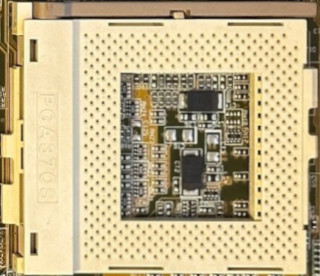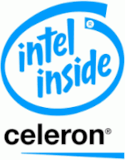1
Cores
1
Threads
30 W
TDP
600 MHz
Frequency
N/A
Boost
Timna
Codename
Socket 370S
Socket


Intel Socket 370S
The Intel Celeron 600 was a desktop processor with 1 core, that was never released. It is part of the Celeron lineup, using the Timna architecture with Socket 370S. Celeron 600 has 128 KB of L2 cache and operates at 600 MHz. Intel is building the Celeron 600 on a 180 nm production process, the transistor count is unknown. The multiplier is locked on Celeron 600, which limits its overclocking capabilities.
With a TDP of 30 W, the Celeron 600 consumes only little energy. The highest officially supported memory speed is 400 MT/s, but with overclocking (and the right memory modules) you can go even higher. Actual memory technology support depends on the chosen motherboard, the processor itself supports multiple memory types, but most motherboards have only one kind of slot. For communication with other components in the system, Celeron 600 uses a PCI-Express N/A connection. This processor features the Intel i752 integrated graphics solution.
Many games will refuse to start on this processor due to the lack of the SSE2/SSE3/SSE4 instruction set.
With a TDP of 30 W, the Celeron 600 consumes only little energy. The highest officially supported memory speed is 400 MT/s, but with overclocking (and the right memory modules) you can go even higher. Actual memory technology support depends on the chosen motherboard, the processor itself supports multiple memory types, but most motherboards have only one kind of slot. For communication with other components in the system, Celeron 600 uses a PCI-Express N/A connection. This processor features the Intel i752 integrated graphics solution.
Many games will refuse to start on this processor due to the lack of the SSE2/SSE3/SSE4 instruction set.
Physical
| Socket: | Intel Socket 370S |
|---|---|
| Process Size: | 180 nm |
| Die Size: | 129 mm² |
| Package: | FC-PGA |
Processor
| Market: | Desktop |
|---|---|
| Production Status: | End-of-life |
| Release Date: | Never Released |
| Part#: | QV17 |
| Bundled Cooler: | None |
Performance
| Frequency: | 600 MHz |
|---|---|
| Turbo Clock: | N/A |
| Base Clock: | 133 MHz |
| Multiplier: | 4.5x |
| Multiplier Unlocked: | No |
| Voltage: | 1.65 V |
| TDP: | 30 W |
Architecture
| Codename: | Timna |
|---|---|
| Generation: |
Celeron
(Timna) |
| Memory Support: |
unknown
Depends on motherboard |
| Rated Speed: | 400 MT/s |
| Memory Bus: | Single-channel |
| ECC Memory: | No |
| PCI-Express: | N/A |
Core Config
| # of Cores: | 1 |
|---|---|
| # of Threads: | 1 |
| SMP # CPUs: | 1 |
| Integrated Graphics: | Intel i752 |
Cache
| Cache L1: | 32 KB |
|---|---|
| Cache L2: | 128 KB |
Features
|
Notes
| "Timna" was cancelled in 2000 but engineering samples were produced and distributed in small quantities along with sample platforms featuring both RDRAM and SDRAM variants. The processor die featured a sophisticated integration of a RDRAM memory controller and i752 graphics core as a means to decrease board complexity and cost. SDRAM boards were possible with the use of the Intel MTH translator chip which incurred a large performance penalty but further decreased cost at the time. |
Sep 26th, 2024 21:06 EDT
change timezone
Latest GPU Drivers
New Forum Posts
- CrystalDisk Info - Hdd (0)
- My latest gaming set up and upgrades, always upgrades (5)
- nvidia rtx 3090 (1)
- Ubisoft comes crawling back to Steam (29)
- TPU's Nostalgic Hardware Club (19055)
- Final Fantasy XVI PC thread (85)
- The Official Thermal Interface Material thread (1545)
- Keyboard suggestion desired (2)
- Your PC ATM (34913)
- [INTEL]-How To Update Your Microcode for Intel HX 13/14th Gen. CPUs Laptops/Mobile Easily. (41)
Popular Reviews
- God of War Ragnarök Performance Benchmark Review - 35 GPUs Tested
- Corsair 3500X ARGB Review
- God of War Ragnarök: DLSS vs. FSR vs. XeSS Comparison Review
- Montech XR Review
- VAXEE XE-S Wireless Review
- God of War Ragnarök Handheld Performance Review
- Final Fantasy XVI Performance Benchmark Review - 35 GPUs Tested
- Orico O7000 2 TB Review
- PCCOOLER RZ820 Review
- Upcoming Hardware Launches 2024 (Updated Jul 2024)
Controversial News Posts
- AMD Confirms Retreat from the Enthusiast GPU Segment, to Focus on Gaining Market-Share (263)
- Sony Reveals the PlayStation 5 Pro, Launches November 7th (213)
- AnandTech Shuts Down, an Icon of Tech News and Reviews Rides into the Sunset (151)
- AMD Ryzen Branch Prediction Optimizations Now Available to Windows 11 23H2 (131)
- Cyberpunk 2077 Update Adds AMD FSR 3 and Frame Generation for PC Players (121)
- AMD Ryzen 5 7600X3D Launched in the US as a MicroCenter-exclusive for $300, Part of a Bundle (119)
- Report: Intel Could Spin Out Foundry Business or Cancel Some Expansion Plans to Control Losses (113)
- NVIDIA RTX 5090 "Blackwell" Could Feature Two 16-pin Power Connectors (105)
